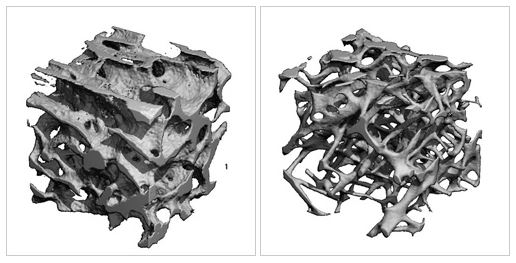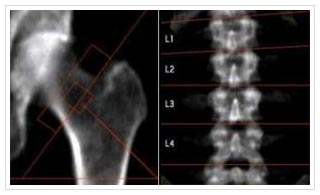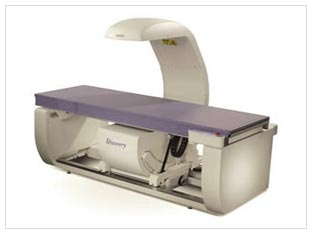Osteoporosis and Osteomalacia (which causes bones to soften) are common bone diseases that endocrinologists diagnose and treat. Osteoporosis is a disease that weakens your skeleton. Certain hormones like estrogen act to protect bone tissue. When hormone levels are abnormal or low, bones can lose calcium and gradually weaken. Menopause in women and loss of testicular function in men and aging may put you at risk for fractures. Endocrinologists treat other disorders that can affect bones such as metabolic bone disease, too much parathyroid hormone and bone issues secondary to long term use of steroids like prednisolone.

Osteoporosis, which means "porous bones", is a condition that causes bones to gradually thin and weaken, leaving them susceptible to fractures. Although all bones can be affected by the disease, those of the spine, hip and wrist are most likely to break. Spine and hip fractures are more dangerous as patients become bed ridden and develop lung infections and clots in their legs. Women are more susceptible because their bones tend to be lighter and less dense. Moreover, hormonal changes after menopause accelerate bone loss and make it weaker.

Indian population have higher risk of developing osteoporosis as they are nutritionally deficient in calcium and Vitamin D in their younger years and fail to achieve peak bone mass around 25–30years. Early marriage and frequent pregnancies weakens their bone health further. Osteoporotic fractures usually occur at least a decade earlier in Indian population when compared to the west. One out of two women suffer from osteoporosis beyond the age of 50 and one out of four have lifetime risk of fractures.
Risk factors for osteoporosis:
- Female sex
- Aging (50+ years)
- Low body weight
- Menopause or surgery to remove both ovaries prior to menopause (resulting in lower levels of the hormone estrogen)
- History of fracture as an adult or fracture in a close relative
- Long-term low calcium and vitamin D intake
- Inadequate physical activity
- Cigarette smoking, alcohol excess
- Use of medications such as steroids, antiseizure medications and overtreatment with thyroid medications
Higher the risk factors, greater the chances of developing osteoporosis
That is a real problem. This thief works quietly and makes a big noise only when something breaks! The first sign of osteoporosis is usually a fracture. We can look out for tell tale signs like loss of height, bending of the back, stooped posture but by then it is too late. The best way to know is to look for risk factors and do screening tests called Bone Mineral Density (BMD) measurement. So if you are at risk it is advisable to get tested for osteoporosis rather than wait for symptoms to develop.
The most widely accepted test is called a dual-energy x-ray absorptiometry or DXA test, which measures bone density at the hip and spine. Though bone density may not always indicate bone strength this test is the simplest and presently the best way to know how strong your spine and hip bones are. It is superior to ultrasound, Xrays and other scans which may be performed for bone density.

Because osteoporosis is difficult to reverse, prevention is the key to treatment, Good strong bones when we are young is like money in the bank. We can draw only from what we have. We need plenty of calcium containing foods, exposure to the sun, physical activity and good nutrition in the growing years.
- Calcium and Vitamin D
- Weight bearing Exercise
- Medications
Calcium and Vitamin D supplementation is the cornerstone of treatment.
Diet rich in calcium are:
- Ragi
- Bengal gram, Rajmah
- Gingely seeds, Almonds, Sesame seeds
- Milk, Yogurt, Cheese
- Cabbage, Fenugreek
- Soybeans, Soy products, Tofu
- Turnip leaves
- Fish with bones
Coffee and too much of salt increases calcium loss in the urine. As the caloric requirement varies among individual patients especially in diabetics and heart patients, it is advisable to consult your doctor or dietitian before making changes in your diet.
How to get Vitamin D?
Vitamin D is the most important substance required for absorbing calcium from food. However most of the food items including milk do not contain enough vitamin D unless fortified. The recent recommendation by National Osteoporosis Foundation have raised the daily requirement of vitamin D from 400 to 800 I.U. (International Units) The cheapest and the best source of vitamin D is exposure to sunlight for atleast 15minutes for that day. Dietary sources include egg yolks and saltwater fish. However it is not possible to fulfill the entire daily requirement of calcium and vitamin D through diet alone. Hence supplementation of calcium and Vitamin D is required for all people who are at risk or have osteoporosis.
What kind of exercise should you do?
Physical activity is also important to prevent osteoporosis and reduce falls that can result in fractures. Weight-bearing activities can help you maintain strong bones.- Walking
- Climbing stairs
- Dancing / Aaerobic exercises
- Examples include:
- Cycling
- Swimming
Medications approved for the treatment of osteoporosis are
- Bisphosphonate drugs
- Alendronate (Fosamax), Risedronate (Actonel), Ibandronate (Boniva), and Zoledronate
- Teriparatide (Forteo): a hormone known as PTH, which is secreted by the parathyroid glands
- Raloxifene (Evista), a Selective Estrogen Receptor Modulator
- Calcitonin (Miacalcin)
- Estrogen and progesterone therapy (also called hormone therapy)
Do's
- Take adequate calcium and Vitamin D
- Regular weight bearing exercise
- Check for osteoporosis if you are at risk.
Don'ts
- Smoking, drinking alcohol
- Anything that could make you fall
- Wait for symptoms to develop.
Spread the word to eat healthy food, drink milk, get sunshine and be active. Know your bone density if you are at risk and get help from experts on bone health.